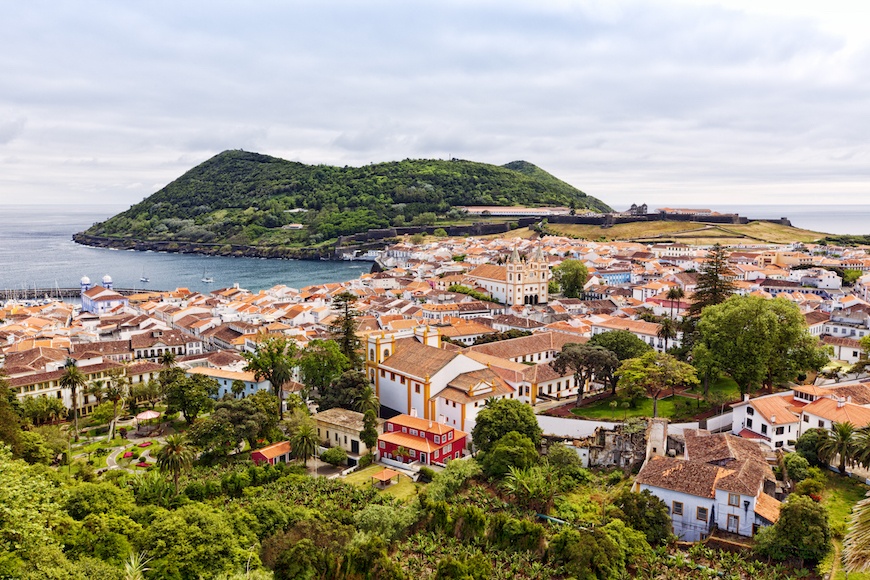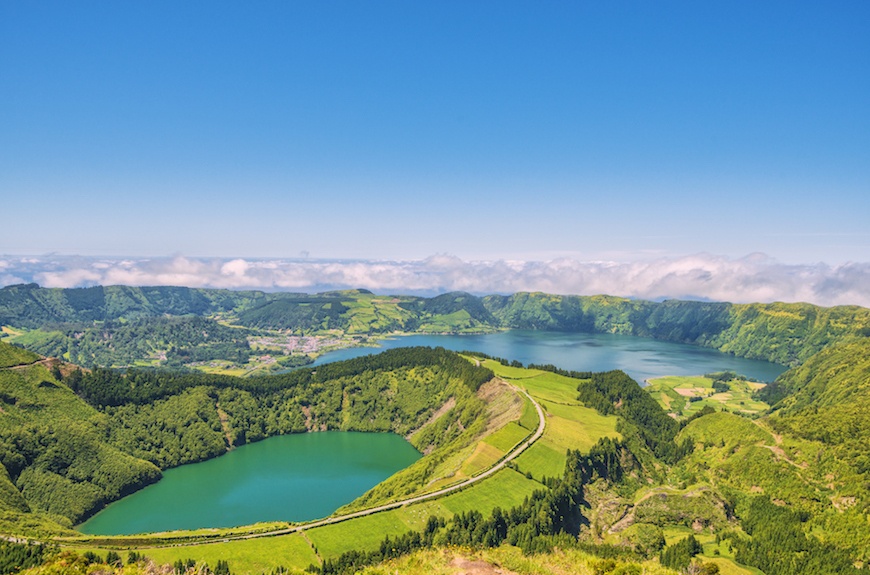I fall squarely in to the latter category. That's why learning my laundromat lost my bag three hours before I’m supposed to board my flight for the Azores, a group of nine volcanic islands off the coast of Portugal, is about as distressing and unsurprising as discovering that the “last round” of burpees really wasn’t the last after all.
I’m hopeful that the single pair of jeans, handful of T-shirts, and little black bathing suit left in my closet will be enough for a long Labor Day Weekend of island hopping around what’s quickly becoming a new healthy hot spot for active travelers looking for an affordable escape off the beaten path. (In other words, Tulum before the DJs and the seaweed started taking over its beaches.)
Sitting at my gate, I go over my itinerary one more time: The plan is to take a five-hour red eye (there are now direct flights to the Azores from both New York City and Boston between Memorial Day Weekend and Labor Day) to Ponta Delgada, the capital of Sao Miguel, which is the largest link in the chain of Mid-Atlantic islands. From there, it’s a short flight to Terceira Island, which is known for its wind farms, lava tubes, and bull fights. I’ll stay there for three days before returning to Sao Miguel, where the main attractions are hiking, swimming in one of several natural saltwater pools that dot its coastline, and soaking up some of its sulfuric thermal waters.

Touching down in Terceira
It’s about a 20-minute drive from the airport to Terceira’s city center, Angra do Heroísmo, a UNESCO World Heritage Site, known for its narrow cobblestone streets, Baroque-style churches, and bakeries that specialize in a traditional Terceiran dessert called the Dona Amelia. (Named after the last queen consort of Portugal, Amélie of Orléans, the tiny, delicious egg tarts or cakes are sweetened with honey and cinnamon before being dusted with powdered sugar.)

{{post.sponsorText}}
I've heard the Azores referred to as the “Hawaii of Europe,” but at first glance, Terceira looks a lot more like Costa Rica to me: lush and pastoral with rolling green hills, forests, and mountain peaks that disappear under swollen clouds. The landscape is dotted with small, whitewashed homes topped by terra-cotta-shingled roofs. The overall effect is akin to a giant green patchwork, quilt thanks to the low stone walls made from volcanic rocks that serve as partitions between pastures for cows—so many cows—to graze: Fifty percent of Portugal’s dairy production comes from the islands.
The Azores have been called the “Hawaii of Europe,” but Terceira looks more like Costa Rica to me: lush and pastoral with rolling green hills, forests, and mountain peaks that disappear under swollen clouds.
In all likelihood, you’ll get stuck in at least one slow-moving cow caravan while navigating the roads that are so windy, everyone seems to drive in the middle. It feels like one neverending game of chicken at every turn. (It's easiest to get around by renting a car, but hiring a driver or signing up for a tour may be safer options.) As I get closer to the coast, cows give way to fields of corn, then car dealerships, then colorful, pastel-hued homes in light blues, yellows, and pinks.
“Welcome to the most beautiful island in the Azores, in my opinion,” says Marina, one of my tour guides, as I arrive at my hotel. It’s hard to argue with her, as she goes on to explain the day's itinerary, which includes taking a hike inside a volcano. Terceira is home to the only place in the world where you can walk into a lava tube, Algar do Carvão. (The only other dormant volcano where visitors can enter a magma chamber is Thrihnukagigur in Iceland, but it requires you to rappel into its crater, NBD.)
Terceira is home to the only place in the world where you can walk into a lava tube, Algar do Carvão.
Algar do Carvão is part of a nature reserve in the heart of Terceira. To keep human impact to a minimum, tours are limited, so it’s worth booking tickets in advance. Entering the lava tube requires walking through a narrow tunnel carved into the side of the mountain that feels very akin to the small door scene in Willy Wonka and the Chocolate Factory. There is light at the end of this tunnel, though, literally, in the form of a magnificent natural skylight (AKA the volcanic crater) through which millions of tons of magma used to spew. Massive staircases have been carved into the cone of the volcano, which is approximately 4.2 million square feet, making it easier to explore.
The same walls that once funneled enough molten basalt rock into the air to create the black sand beaches the Azores are known for are now covered in plant vegetation, creating one truly epic living green wall. The juxtaposition is jarring, but as your eyes adjust to the light and the lush interior, it’s utterly tranquil—not what I expected to feel while hanging out in a volcanic vent. As I descend deeper into the tube, the plant walls are replaced by rusty rock beds that give off the decidedly more Dante’s Inferno vibe you’d expect from a volcano.

Taking in the sights and smells of Sao Miguel
Compared to Terceira, Sao Miguel feels considerably more cosmopolitan. Ponta Delgada is a busy port city with bigger hotels and more bars and restaurants, which attract a steady stream of tourists during its summer high season. Whether you’re flying directly to the island or tacking a couple of days onto a trip from Lisbon, spending time in Sao Miguel is the easiest way to experience the Azores.
Here, I stay at the Grand Hotel Açores Atlântico. The five-star hotel overlooks the Baixa de Sao Pedro, a port popular for its whale watching tours. (You can often spot sperm and pilot whales, as well as the occasional humpbacks off the Azorean coasts.) But I don’t spend much time inside, as Sao Miguel is really known for its outdoor recreational activities and natural wonders. The first on my list being Boca do Inferno, a world-famous lookout that affords hikers a 360-degree view of the island, including the volcanic crater lakes the dot its interior.
The road to Sete Cidades, the area in Sao Miguel where Boca do Inferno is located, is winding, hugging the craggy cliffs that make up Sao Miguel’s shoreline. Unlike in Terceira where the pastures are divided by rock walls, in Sao Miguel, the farmland is divided by hydrangea bushes of the deep blue and purple varieties. “When they’re in bloom, it’s really quite beautiful,” says Catarina Maia, a tour agent for Azores Getaways. By late August, the flowers have faded from the fields, but the bushes are still green, lending a lush trim to the otherwise grassy hillsides. Driving around Sao Miguel, it’s clear why the locals call it the “Green Island.”
When my car comes to a stop at the edge of a forest tree line, I step out onto a red clay road and start climbing a flight of stairs carved out of the side of a volcano. At the top is a view unlike any other: two crater lakes created out of the eruptions that formed the island sit at the bottom of a gorgeous green valley. The only thing that makes me want to climb back down is that I know our next stop is another place special to Sao Miguel: Furnas Valley. As its name implies, it’s a literal hotbed for geothermal activity, hosting two active volcanic sites that attract tourists and locals alike.
My first stop is Furnas Lake where Azoreans come by the dozens before dawn to bury clay pots called caldeiras full of a traditional stew called cozido. The dish consists of half a dozen different types of meat, plus potatoes, cabbage, carrots, and kale and is cooked over several hours by the volcanic steam.
The scent of sulfur is strong enough to identify before I even open my car door. But by the time we make it to our second stop in Furnas, Terra Nostra Park, I hardly notice the eau de rotten eggs in the air. Tucked inside its grounds is the Terra Nostra Garden Hotel, one of Sao Miguel’s swankiest accommodations, where a day pass grants access to its hot springs and botanic garden. The temperature of the thermal water pool fluctuates between 95 to 104 degrees Fahrenheit, and its color can best be described as a very dark golden milk latte due to the sulfur content of the geothermal H2O.
As I submerged myself into the approximately four-foot deep tank, I’m immediately grateful that I didn’t bring a lighter bathing suit. While the water looks murky, it’s clear within minutes why a dip in the essential mineral-charged waters are a main attraction, not only of Sao Miguel, but all the Azores: The effect is energizing and relaxing at once. All that’s left to do now is sit back and soak up a little sun (and sulfur)—and wonder whether the laundromat located my clothes.
Does Sao Miguel have hot springs on your mind? Check out these worldwide options. And why you should bookmark this geothermal spring in Austria for a future visit.
Loading More Posts...